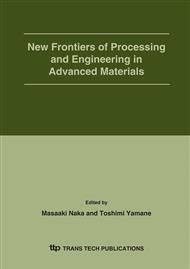p.411
p.417
p.425
p.431
p.437
p.443
p.449
p.455
p.461
Microstructure and Mechanical Properties of Hyper-Interfacial Bonded Joints of Ultra-Fine Grained High Strength Steels
Abstract:
A new conceptual bonding technique, " hyper-interfacial bonding" has been proposed as the most effective bonding technique for ultra-fine grained steels. The hyper-interfacial bonding process was characterized by the instantaneously surface-melted pressure-bonding which involved a series of steps, namely, surface heating by high frequency induction, rapid removing of a heating coil and simultaneously pressing of specimens together by an oil pressure system. All equences were typically completed within a second under vacuum/gas atmosphere. An ultra-fine grained high strength steels with the average grain size of 1.0-1.5µm were used for bonding. A bainitic structure and MAconstituents were confirmed in the HAZ, while the base metal indicated the fine ferrite-cementite/ pearlite texture. The maximum hardness in HAZ was limited at HV320-400 and the softening in the HAZ did not occur consequently. Prior austenitic grains were coarsened at the vicinity of the bond interface, however, the grain growth in the bond layer could be depressed below about 11-16µm attributed to the dynamic recrystallization during pressure-bonding process. The tensile strength of joints attained to 83% of the base metal strength. The upper-shelf absorbed energy and DBTT were improved to approx. 60J/cm2 and 223K respectively in the case of Ni-plated UFG steel joints. It could be resulted that the hyper-interfacial bonding technique was a feasible joining method for ultra finegrained steels.
Info:
Periodical:
Pages:
437-442
Citation:
Online since:
December 2005
Authors:
Price:
Сopyright:
© 2005 Trans Tech Publications Ltd. All Rights Reserved
Share:
Citation:


